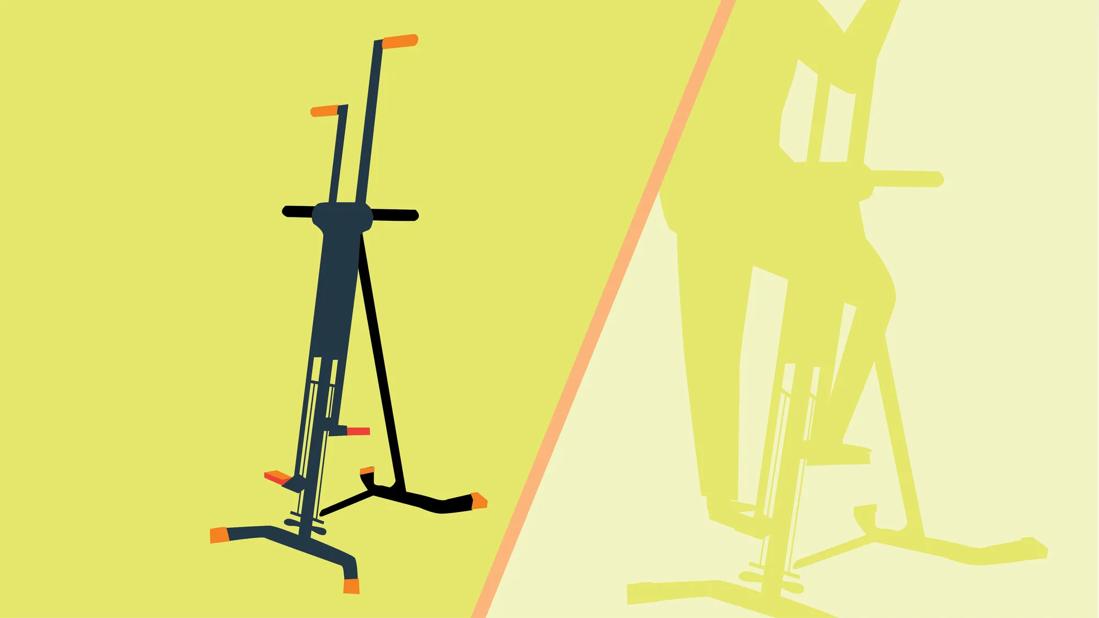Climbing machines offer full-body results with cardio- and strength-training benefits

If you want to take your fitness to a new level, bring the spirit of mountain climbing to your exercise routine.
Advertisement
Cleveland Clinic is a non-profit academic medical center. Advertising on our site helps support our mission. We do not endorse non-Cleveland Clinic products or services. Policy
Working out on a vertical climbing machine mimics cliff-scaling movements to offer a full-body challenge. It combines the heart-thumping benefits of cardio with the muscle-building gains of strength training.
Best of all? You don’t have to worry about heights or high-altitude sickness, as you’ll only be a foot or so off the ground in your own home or the gym. (The view, however, won’t match the Rocky Mountains.)
So, let’s explore the high points of a vertical climber workout routine with exercise physiologists Katie Lawton, MEd, and Christopher Travers, MS.
It’s hard to miss a vertical climber at the gym, as it’s a contraption that may stand up to 7 feet tall, says Travers. The machine features platforms for each of your feet and grips for your hands.
Your body will be at about a 75-degree angle as you “climb” in a rhythmic motion that involves pushing up with one arm while pushing down with the opposite leg. (Basically, think of how Spider-Man looks crawling up the side of a building.)
The weight-bearing movement engages muscles in your upper body, lower body and core.
“The vertical climber is different than a bike or treadmill because you’re engaging your entire body,” explains Travers. “Moving vertically uses muscles that might otherwise not be used as frequently. It can be challenging, but it’s very effective.”
Advertisement
Here are five reasons why you might want to consider adding a vertical climber to your exercise routine.
A vertical climber workout checks a lot of boxes when it comes to targeting muscle groups, says Lawton. Biceps, triceps and shoulders? Those arm and upper body muscles will get put to the test.
Ditto for your glutes, quads, hamstrings and calves in your lower body as you power your legs. Plus, the asymmetrical stretching movement also activates core muscles like your abs and obliques.
“It’s a workout that targets muscles up and down your body,” says Travers.
The vertical climber is a high-calorie output machine. It heightens your VO2 max, a fancy way of tracking how fast your body consumes oxygen and how that translates into calories burned and energy used.
You can expect to burn between 600 and 800 calories an hour on a vertical climber, according to industry estimates. That’s more than you’d burn using a treadmill, elliptical, rowing machine or stationary bike.
“It’s a much more intense workout because you have so many muscle groups engaged,” notes Lawton. “You’re going to be using a lot more energy.”
Burning calories through exercise can help you shed pounds or keep weight off. Muscle gains from using a vertical climber can boost your metabolic rate to keep those calorie-burning fires cooking longer, too.
The gliding up-and-down mechanism on a vertical climber makes it a relatively low-impact activity, particularly for your ankles, knees and hips. You’re not subjecting those joints to the pounding that comes with something like running.
“It’s safe for people with joint or back issues,” adds Travers.
The intensity of a vertical climber workout means you can get maximum results in a short amount of time. You can get a good workout on a vertical climber in 10 to 20 minutes, making it ideal for anyone with a busy schedule.
“You won’t be on the vertical climber for hours at a time,” notes Travers. “It’s a quick, total-body workout designed for maximum efficiency.”
A vertical climber offers more workout options than you might imagine given that it focuses on one basic motion. Adjusting your pace, range of motion and the machine’s resistance can add surprising variety.
Let’s break down your options.
Advertisement
Some vertical climbers come with pre-programmed workouts for you to try, shares Lawton. In addition, an online search can turn up numerous plans that promise to give your body all it can handle.
There’s no question that vertical climbers can offer an intense workout. Could it be too intense? It might in some cases. “If you’re dealing with heart issues, it’s always best to get clearance from your cardiologist or healthcare provider,” advises Lawton.
Vertical climbers also may not be ideal if you have a shoulder injury, given the upward arm motion. Again, talk to a healthcare provider.
Bottom line? Climbing has always been a natural human activity. Vertical climbers — which have been around since the 1980s — take that ingrained trait and turn it into a muscle-building, calorie-burning workout.
“They may look intimidating, but don’t be afraid to try them,” encourages Lawton. “There’s a lot to be gained if you work it into your exercise routine.”
Advertisement
Learn more about our editorial process.
Advertisement

You can improve your athletic performance over time by breaking up your workout regimen into focused cycles

Lower-intensity workouts can deliver high-quality health and fitness results

Incremental changes in your exercise routine can improve your strength and endurance over time

Understanding heart rate zones can help you tailor your workout to reach your goals

Increase the size of your muscles by bulking up on protein and focusing on slow, intense movements with progressive overloading

Low-impact exercises help you recover faster between sets, during cool downs and on rest days

Eccentric is slow and steady, while concentric is fast and controlled

Weightlifting can help you build muscle mass, reduce joint pain and increase flexibility to improve your quality of life

The best parenting style balances enforcing rules and showing plenty of love

Tips include cutting back on sugar, focusing on exercise and managing stress

It can be harder to let go when you’ve invested time, energy and emotions — but it might be the healthier choice long term